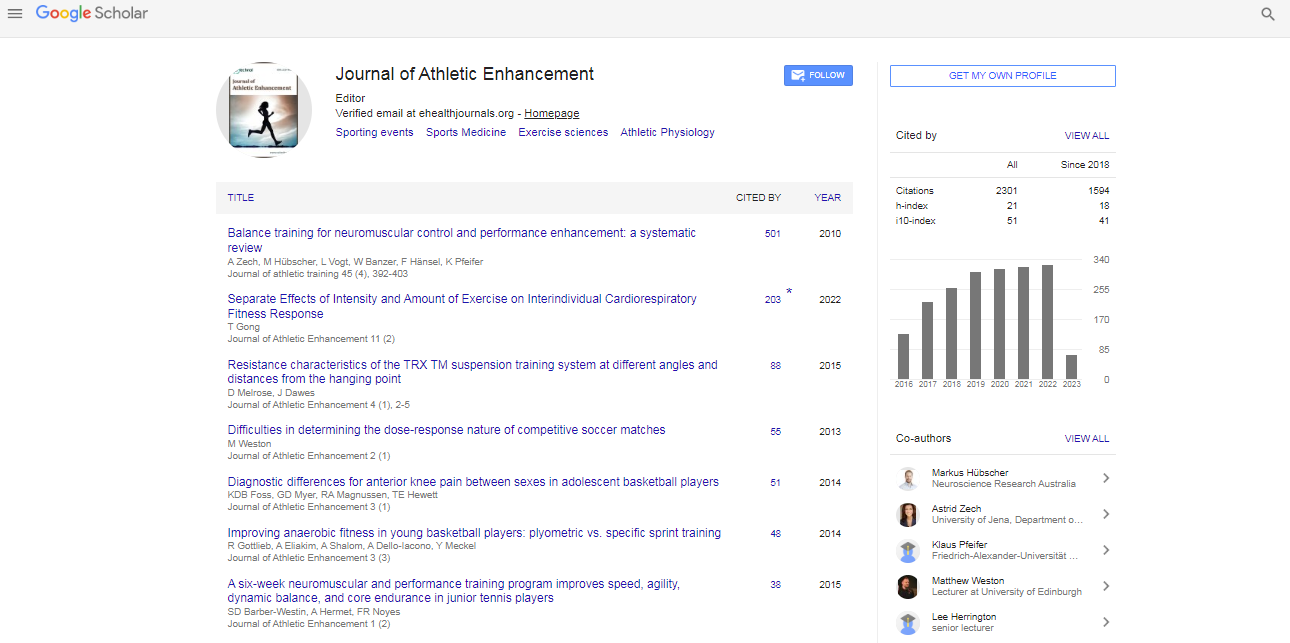Perspective, J Athl Enhanc Vol: 13 Issue: 1
The Importance of Physical Activity: A Gateway to Well-Being
Jian Lin*
1Department of Physical Education, Shijiazhuang Tiedao University, ShiJia Zhuang, China
*Corresponding Author: Jian Lin,
Department of Physical Education,
Shijiazhuang Tiedao University, ShiJia Zhuang, China
E-mail: linjian@stdu.edu.cn
Received date: 18 December, 2023, Manuscript No. JAE-24-131152;
Editor assigned date: 21 December, 2023, PreQC No. JAE-24-131152 (PQ);
Reviewed date: 04 January, 2024, QC No. JAE-24-131152;
Revised date: 11 January, 2024, Manuscript No. JAE-24-131152 (R);
Published date: 18 January, 2024, DOI: 10.4172/2324-9080.1000111
Citation: Lin J (2024) The Importance of Physical Activity: A Gateway to Well-Being. J Athl Enhanc 13:1.
Description
In an era marked by sedentary lifestyles and technological advancements that often tether us to our seats, the significance of physical activity cannot be overstated. Physical activity encompasses a broad spectrum of movements, from brisk walking to intense workouts, all of which contribute to the holistic well-being of individuals. This article aims to delve into the multifaceted benefits of physical activity, elucidating its impact on physical health, mental well-being, and overall quality of life.
Physical health benefits
Regular physical activity is synonymous with a plethora of health benefits that extend beyond mere weight management. Engaging in physical exercises strengthens the cardiovascular system, reducing the risk of heart diseases, strokes, and hypertension. Moreover, it enhances respiratory function, fostering efficient oxygen exchange in the body. The musculoskeletal system reaps rewards from weightbearing activities, fortifying bones and muscles, thereby mitigating the likelihood of osteoporosis and fractures. Notably, physical activity also bolsters the immune system, rendering individuals less susceptible to infections and diseases.
Mental well-being
Beyond its physiological advantages, physical activity serves as a potent elixir for mental health. Exercise stimulates the release of endorphins, neurotransmitters renowned for their mood-enhancing properties. Consequently, individuals who partake in regular physical activity often report reduced feelings of stress, anxiety, and depression. Moreover, engaging in physical exercises fosters cognitive function and memory retention, thereby safeguarding against agerelated cognitive decline and neurodegenerative disorders. The sense of accomplishment derived from achieving fitness goals further boosts self-esteem and confidence, fostering a positive self-image.
Enhanced cognitive function
The symbiotic relationship between physical activity and cognitive function is increasingly evident in contemporary research. Physical exercises promote neuroplasticity, facilitating the growth of new neural connections and enhancing cognitive flexibility. Furthermore, cardiovascular workouts improve blood flow to the brain, augmenting its oxygen and nutrient supply, which is vital for optimal cognitive performance. Studies have shown that children who engage in regular physical activity exhibit improved academic performance and enhanced concentration levels. Similarly, in adults, exercise has been linked to sharper cognitive acuity and a reduced risk of cognitive impairment.
Social interaction and community engagement
Physical activity often serves as a conduit for social interaction and community engagement, fostering a sense of belonging and camaraderie. Group-based activities such as team sports, group fitness classes, and recreational clubs provide opportunities for individuals to connect with like-minded peers, thereby combating social isolation and loneliness. These social connections not only enrich one's social support network but also imbue life with a sense of purpose and fulfillment.
Longevity and quality of life
The cumulative effect of physical activity on longevity and quality of life cannot be overstated. Numerous longitudinal studies have demonstrated a strong correlation between regular exercise and increased life expectancy. By mitigating the risk of chronic diseases and enhancing overall health, physical activity lays the foundation for a vibrant and fulfilling life. Moreover, the benefits of physical activity extend well into old age, promoting functional independence and preserving mobility, thereby enhancing the quality of life in later years.
Overcoming barriers to physical activity
While the benefits of physical activity are indisputable, numerous barriers impede its adoption and adherence. Socioeconomic factors, time constraints, and environmental barriers such as lack of access to safe recreational spaces often deter individuals from engaging in regular physical activity. Addressing these barriers necessitates a multifaceted approach encompassing policy interventions, community initiatives, and individual empowerment. By fostering environments that prioritize physical activity and promoting inclusive participation, society can surmount these obstacles and empower individuals to lead healthier, more active lifestyles.
Physical activity is not merely a discretionary pursuit but a fundamental pillar of health and well-being. Its profound impact on physical health, mental well-being, cognitive function, and overall quality of life underscores its indispensability in contemporary society. By advocating for a culture of active living and fostering environments conducive to physical activity, we can unlock the transformative potential of movement, enabling individuals to thrive physically, mentally, and emotionally. As we navigate the complexities of modern life, let us not overlook the simple yet profound act of moving our bodies a gateway to vitality and flourishing.
 Spanish
Spanish  Chinese
Chinese  Russian
Russian  German
German  French
French  Japanese
Japanese  Portuguese
Portuguese  Hindi
Hindi 
